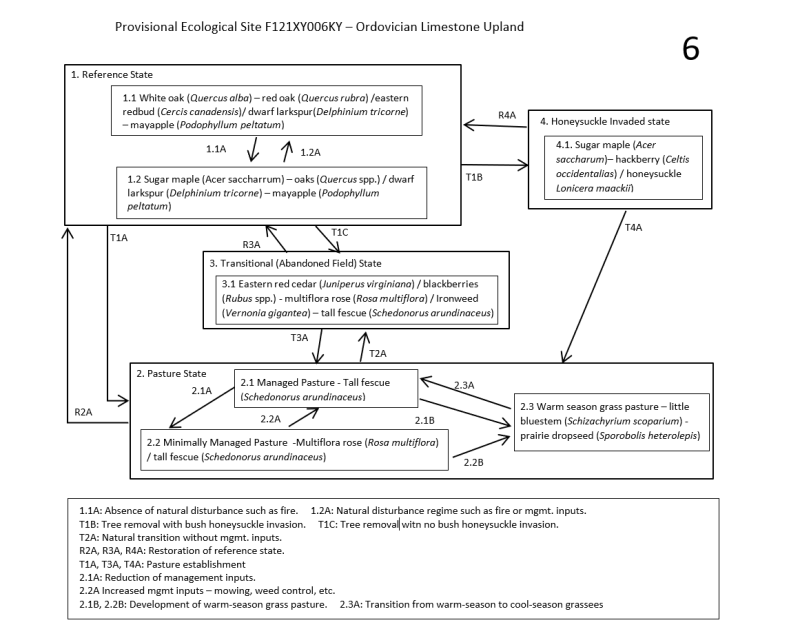
Natural Resources
Conservation Service
Ecological site F121XY006KY
Ordovician Limestone Upland
Last updated: 10/01/2024
Accessed: 12/21/2025
General information
Provisional. A provisional ecological site description has undergone quality control and quality assurance review. It contains a working state and transition model and enough information to identify the ecological site.
MLRA notes
Major Land Resource Area (MLRA): 121X–Kentucky Bluegrass
General: The project area is in Kentucky (83 percent), Ohio (11 percent), and Indiana (6 percent). It makes up about 10,680 square miles (27,670 square kilometers). The cities of Cincinnati, Ohio, and Louisville, Frankfort, and Lexington, Kentucky, are in this area.
Physiography: MLRA 121 is primarily in the Lexington Plain Section of the Interior Low Plateaus Province of the Interior Plains.
Soils: The dominant soil orders in MLRA 121 are Alfisols, Inceptisols, and Mollisols. The soils in the area dominantly have a mesic soil temperature regime, an udic soil moisture regime, and mixed mineralogy. They are shallow to very deep, generally well-drained, and loamy or clayey. Hapludalfs formed in residuum on hills and ridges (Beasley, Cynthiana, Eden, Faywood, Lowell, and McAfee series) and in loess over residuum on hills and ridges (Carmel and Shelbyville series). Paleudalfs (Crider and Maury series) formed in loess or other silty sediments over residuum on hills and ridges. Fragiudalfs (Nicholson series) formed in loess over residuum on ridges. Hapludolls formed in residuum on hills and ridges (Fairmount series) and in alluvium on floodplains (Huntington series). Eutrudepts (Nolin series) formed in alluvium on flood plains.
Geology: Most of this area has an Ordovician-age limestone that has been brought to the surface in the Jessamine Dome, a high part of a much larger structure called the Cincinnati Arch. The strata of limestone have a propensity to form caves and karst topography. Younger units of thin-bedded shale, siltstone, and limestone occur at the eastern and western edges of the area.
The area has no coal-bearing units. Pleistocene-age loess deposits cover most of the bedrock units in this MLRA, and some glacial lake sediments are at the surface in the northwest corner of the area. Unconsolidated alluvium is deposited in the river valleys.
Classification relationships
Quercus alba -- Quercus rubra - Quercus muehlenbergii/ Cercis candensis Forest. Interior Highlands Dry-mesic forest. (Plant communities of the Midwest)
Calcareous sub-xeric forest: Kentucky State Nature Preserves Commission
Calcareous mesophytic forest: Kentucky State Nature Preserves Commission
Ecological site concept
Thie Ordovician Limestone Upland ecological site includes soils of varying depths formed, at least in part, on Ordovician limestone in MLRA 121. Representative soils include: Aaron, Alfic Udarents, Beasley, Brashear, Bratton, Caleast, Caneyville, Carmel, Chenault, Donerail, Grayford, Hagerstown, Heitt, Lowell, Sandview, Shelbyville, Vertrees.
Forests on these limestone-influenced sites are generally oak-hickory, oak-cedar or more mesic maple-oak types. Understory communities are usually well-developed and contain herbs and forbs that thrive on limestone soils.
State 1. (Reference)
State 1, Phase 1.1: Plant species dominants:
Quercus alba-Quercus rubra /Cercis canadensis /Delphinium tricorne-Podophyllum peltatum (White oak – red oak / eastern redbud / dwarf larkspur – mayapple)
State 1, Phase 1.2: Plant species dominants: Acer saccharum.-Quercus spp.//Delphinium tricorne - Podophyllum peltatum
Phase 1.1 to Phase 1.2
The absence of a natural fire regime and a history of disturbances (logging, grazing, etc.) are influences that will move this community from phase 1.1 to 1.2. The transition creates a more mesic, shady environment which enhances the reproduction of quick growing, fire intolerant, shade-tolerant species such as maples and reduces the successful regeneration of oaks and hickories.
Phase 1.2 to Phase 1.1
Fire, timber stand improvement activities or drought can influence this community to shift more toward the reference forest of oak-hickory.
State: 2. Pasture
State 2, Phase 2.1: Managed Pasture. Plant species dominants: Schedonorus arundinaceus (tall fescue)
State 2, Phase 2.2: Minimally Managed Pasture. Plant species dominants: Rosa multiflora- Rubus spp. /Schedonorus arundinaceus
State 2, Phase 2.3: Warm season grass pasture. Plant species dominants: Schizachyrium scoparium- Sporobolus heterolepis
State: 3 – Transitional (Abandoned Field)
State 3, Phases 3.1: Plant species dominants: Juniperus virginiana/ Rubus spp.- Rosa multiflora/ Vernonia gigantea -Schedonorus arundinaceus
Eastern red cedar /blackberry – multiflora rose/ ironweed- tall fescue
State: 4. Honeysuckle Invaded Woodland
State 4, Phase 4.1: Plant species dominants: Acer saccharum – Celtis occidentalis/ Lonicera maackii
Table 1. Dominant plant species
| Tree |
(1) Quercus alba |
|---|---|
| Shrub |
(1) Cercis canadensis |
| Herbaceous |
(1) Delphinium tricorne |
Click on box and path labels to scroll to the respective text.
